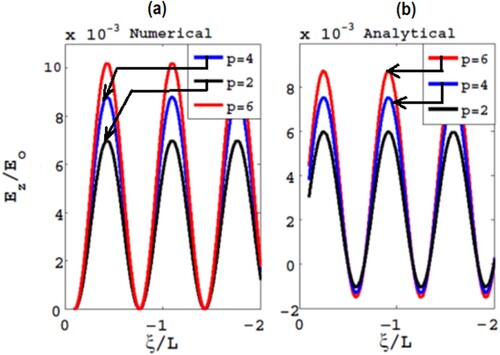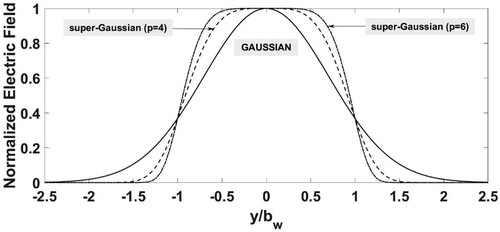 ?Mathematical formulae have been encoded as MathML and are displayed in this HTML version using MathJax in order to improve their display. Uncheck the box to turn MathJax off. This feature requires Javascript. Click on a formula to zoom.
?Mathematical formulae have been encoded as MathML and are displayed in this HTML version using MathJax in order to improve their display. Uncheck the box to turn MathJax off. This feature requires Javascript. Click on a formula to zoom.Abstract
The present calculations show that the application of an external magnetic field can generate additional component of the wakefield suitable for Terahertz (THz) radiation generation in a collisional plasma. Based on the approach of perturbation technique under quasi-static approximation, a study is made on the field of emitted radiation pulses from the wakefield when the super-Gaussian laser beams are used. The field of the radiation becomes stronger when stronger magnetic field is applied and the same is the case for the lasers of higher index.
1. Introduction
The interaction of intense laser with matter, viz. solid, gas or plasma, is an interesting field in view of its tremendous applications in fusion [Citation1], generation of harmonics [Citation2], plasma channels [Citation3], acceleration of particles via wakefield [Citation4], etc. The THz radiations with frequency ranging from 100 GHz to 10 THz have applications in communication, characterization of materials, imaging, etc. These radiations can be achieved by Cherenkov wakes [Citation5–8] and inverse Compton scattering based on X-ray radiation [Citation9] including hard X-ray (table-top) source [Citation10]. Kacar et al. [Citation11] have investigated, both theoretically and experimentally, soft X-ray emissions from TIN plasmas. They kept their lithographic application in mind and also discussed the mechanism in terms of enhanced efficiency. Dorranian and co-workers [Citation12–14] have reported the generation of radiation based on laser pulse and magnetized plasma interaction. Starodubstov et al. [Citation15] have also done extensive studies on the plasma based radiation generation. Mun et al. [Citation16], during the laser and gas interaction, established a relationship between the signals corresponding to the THz radiation and X-rays; they understood the THz radiation to be due to the coherent transition radiation. Nakajima [Citation17] has reviewed the progress of laser driven electron beam and radiation sources and mentioned their various applications. If we focus on the very recent research, we find remarkable work on THz radiation using crystals [Citation18], metal–dielectric layers [Citation19], medium containing nanoparticles [Citation20] and ferromagnetic heterostructures [Citation21]. In optical rectification technique, this has been experimentally shown that the emitted THz radiation depends on the crystal orientation and excitation polarization in the case of BaGa4Se7 crystal [Citation18]. Considering a metal in contact with a nanolayer of dielectric, femtosecond lasers are found to generate THz radiation in dielectric–metal structure, where the field can be enhanced due to interference of incident and reflected waves in the dielectric [Citation19]. The oblique incidence of a femtosecond laser on W/CoFeB/Pt trilayer heterostructures has shown to scale up the stable THz emission if one uses the remnant magnetization and this can have application in Spintronic Terahertz Emission Microscopy (STEM) in view of its high performance [Citation21]. On the other hand, it has been shown that the emitted THz radiation can be tuned with respect to its power and focus by manipulating the shape and orientation of nanoparticles embedded in a gaseous medium [Citation20].
The researchers all over the world are putting their efforts to generate the THz radiation sources where the laser plasma interaction has vital role to play. There are a lot of studies on laser plasma interaction, which talk about different mechanisms [Citation22–38]. Extremely powerful THz radiations have been achieved by interaction of chirped [Citation24], few cycle laser pulses [Citation25] and tailored laser pulses [Citation26] with plasmas. In this regard, Villa et al. [Citation27] have been able to shape and characterize laser pulses for high gradient accelerators and Ostermayr et al. [Citation28] and Malik and co-workers [Citation31,Citation32] have employed super-Gaussian (sG) pulse for laser plasma interaction with regard to their self-focusing effect. We have also made theoretical investigations for the efficient use of super-Gaussian lasers for obtaining THz radiation based on laser beat process [Citation29,Citation34]. This is understood that plasma dynamics can be controlled by playing with the shape of the laser pulses and tunable THz radiation can be achieved.
As is clear from the above work that the lasers have been used to excite wakefield in plasmas [Citation12,Citation14,Citation23,Citation26,Citation30,Citation33,Citation35,Citation36] and this field has been found to be tailored based on the shapes of the laser / microwave pulses [Citation39–42]. In the present work, we show that the application of an external magnetic field can generate a transverse component of the wakefield which serves as the THz radiation source and we can tune the radiation by the use of super-Gaussian lasers. For the sake of completeness, we also include the collisions those have been neglected by other investigators.
2. Nonlinear current generation
A super-Gaussian laser beam (index-"p") having ω and k as its frequency and wave number is considered to propagate in the z-direction in plasma having density n0. Electric field of the laser is assumed to be , where
represents the amplitude of the laser. The expression with the value of p greater than 2 (but even numbers) represents the super-Gaussian laser whereas p = 2 corresponds to the Gaussian laser. In the expression,
is the laser’s beam width. A magnetic field (strength B) is applied in the perpendicular direction, i.e. in the x- direction. In the forthcoming discussion we shall write E0 for E00 which represents the highest field of the laser.
For obtaining the expression for the wakefield, we make use of reductive perturbation technique (RPT). In RPT, the plasma density, electron velocity, current density etc. are expanded in terms of smallness parameter “a” which is the laser strength parameter (<< 1). This can be seen that a = 0.12 for the laser’s electric field E0 = 5 × 108 V/cm and frequency ω = 2.4 × 1014 rad/s. This satisfies the condition for its use in the expansion of physical quantities. Hence, the plasma density is expanded as
, electron velocity as
and current density as
.
In view of the larger mass of ions, only the electrons are assumed to oscillate whose dynamics is governed by the following equation, where ν represents the frequency of electron-neutral collisions
(1)
(1)
This equation is valid for a single electron as well as for the electron fluid. This equation in view of the expanded quantities is expressed as
(2)
(2)
The above equation is used to get various order components of velocity. These are obtained as
(3a)
(3a)
(3b)
(3b)
Here is the electron gyrofrequency in view of the fact that the magnetic field is applied in the x-direction. Now under the influence of the said magnetic field, the electron oscillations create nonlinear density perturbations. Following equation of continuity along with n(0)= n0 (ambient plasma density with n the same as N) is used for obtaining the density perturbations
(4)
(4)
The expanded equation of continuity using reductive perturbative technique (RPT) is expressed as
The density does not stay constant but varies in all the directions. For example, its variation in x-, y- and z-directions is obtained from the above equation as
(5)
(5)
We make the use of zero order components of velocity and density for finding higher order quantities. A nonlinear plasma current is generated by the density perturbations in the plasma, which at different orders is obtained from . Actually the laser’s electric field provides an oscillatory velocity to the electrons but in the presence of external magnetic field, a Lorentz force is also acted on them and it leads to the perturbations in the electrons velocity / density. This constitutes the nonlinear current in the plasma. The components of this current density are obtained as
(6a)
(6a)
(6b)
(6b)
(6c)
(6c)
These nonlinear current densities are important quantities which help getting additional components of the wakefield and hence, the THz radiation emission in collisional magnetoactive plasma.
3. Calculation of wakefield and Terahertz radiation generation
Following Maxwell’s equations are used for obtaining the wakefield components
(7)
(7)
(8)
(8)
The electric and magnetic fields corresponding to the wakefield are represented by and
in the above equations. Considering the situation where laser pulse does not evolve during its propagation, we write all the components of Maxwell’s equations in terms of transformed coordinate
, where υg represents the laser’s group velocity. Hence
(9a)
(9a)
(9b)
(9b)
(9c)
(9c)
(9d)
(9d)
(9e)
(9e)
(9f)
(9f)
The equation of motion is now evaluated for the first order velocity components, i.e.
(10a)
(10a)
(10b)
(10b)
(10c)
(10c)
The use of Equations (9c) and (9f) in Equation (10c) finally gives
(11)
(11) where,
is recognized as the wave number corresponding to the plasma wave. This equation is written in terms of the longitudinal component of the wakefield, based on which we can also calculate the transverse component using Equation (9). We solve Equation (11) with the initial condition that
at
and L/2, where L is the length of the laser pulse. This gives
(12)
(12)
Here, , which depends on the field of the laser, electron-neutral collision frequency and cyclotron frequency. The transverse components of the wakefield in terms of the horizontal wake are obtained from the following relations
(13)
(13)
On further solving Equation (13) for x- and y- components of generated transverse fields, we understand that the wakefield along the magnetic field is not realized, i.e. However, transverse component of the field yields the following THz field.
(14)
(14)
People have used the wakefield for the particle acceleration, and they also observed weak transverse component of the same. The transverse wake component can be utilized for the THz radiation generation. From Equation (14) we can obtain the position of maximum amplitude of THz radiation by differentiating it w.r.t ξ. So we put and obtain that the THz field maximizes at ξ = − L/4.
4. Results on wakefield
Figures (a) and (b) show the transverse profile of the longitudinal wakefield (normalized with laser field) with the dependence on the electron-neutral collision frequency ranging from 0.05ωp to 1.5ωp. It is clear that the field carries higher magnitudes when the electron-neutral collisions are less in the plasma. For example, the field attains lowest magnitude when ν = 1.5ωp and largest magnitude when ν = 0.05ωp. The decay in the longitudinal wakefield due to collisions is attributed to the loss of energy and momentum involved. On the other hand, this is depicted very clearly from the figures that the normalized longitudinal wakefield attains a maximum value at a particular position of y/bw. This maximum amplitude is attributed to the largest amount of nonlinear current at a particular position, which is due to the ponderomotive force attaining the largest value at this specific position. The magnitude of nonlinear current strongly depends on the pulse profile of the laser pulse, collision frequency and external magnetic field. Also a comparison of Figures (a) and (b) yields that the effect of magnetic field is to enhance the amplitude of the wakefield, similar to the case of skew-coshyperbolic Gaussian lasers used for excitation of wakefield and its conversion to THz radiation [Citation36]. Skew-coshyperbolic lasers have also been found to produce bifocal THz radiation where its conversion to unfocal THz was possible [Citation37] in different mechanism. The laser’s different shapes have been found to contribute significantly in another field also [Citation43,Citation44]. From the fast rise of wakefield in Figure (b), this seems plausible that the decay due to collisions can be supplemented with the application of appropriate strength of the external magnetic field.
Figure 1. Transverse profile of longitudinal wakefield for various collision frequencies when E0 (≡ E00) = 5×108 V/cm, p = 8, ω = 2.4×1014 rad/sec, ωp = 2.0×1013 rad/sec, L = 0.5λp and ξ = − 0.25L.
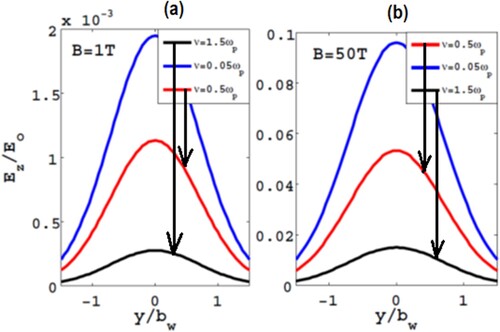
Figures (a) and (b) compare the nature of wakefield obtained numerically (Figure a) and analytically (Figure b) from Equation (11) for different values of sG index p = 2 (black), 4 (blue) and 6 (red). It is found that there is qualitatively a close resemblance in the behaviour of field profiles obtained numerically as well as analytically, but the field amplitudes differ a bit. This figure enables us to see the results for the Gaussian (p = 2) and super-Gaussian (p > 2) lasers. This is interesting that the field amplitudes for Gaussian laser (p = 2) are much lower than the amplitudes obtained with the help of sG laser. Therefore, sG lasers are more suitable for causing excitation of large amplitude wakefield due to generation of larger currents in the plasma. Details about the profile and features of super-Gaussian lasers may be followed from our earlier work [Citation34].
5. Results on THz emission
This is seen from Equation (14) that the amplitude of transverse field directly depends on the sG index-p and the beam width bw of the laser. Therefore, by controlling these laser parameters we can obtain higher amplitude of THz radiation. Figures (a) and (b) show the dependence of THz field amplitude on the laser beam width for different electron-neutral collision frequency and sG index. It is clear from the figures that the THz field amplitude is decreased as the beam width is increased. This behaviour can be understood based on the stronger gradient in the laser field for small beam widths because of which larger current is expected to be generated in the plasma. On the other hand, when the collision frequency is increased from ν = 0.05ωp to ν = 0.5ωp, the amplitude of THz field reduces significanly.
Figure 3. Dependence of THz field amplitude on beam width for laser of various sG index in a plasma of different collision frequency when E0 = 5×108 V/cm, ω = 1.15ωp, ωp = 2.0×1013 rad/sec, B = 1Tesla, y = 0.8bw, L = 0.5λp and ξ = − 0.8L.
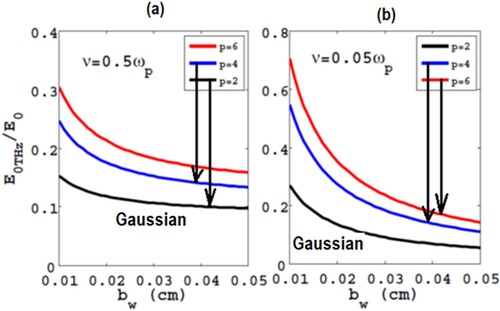
The impact of collision frequency on the THz field is clearly shown in Figure . Here, it is observed that the negative impact of ν is not so significant till ν ≈ 0.3 ωp. However, there is a drastic reduction in the field for ν > 0.3 ωp. From these results it appears that high density plasma is more suitable for the effective THz emission. Moreover, these results are consistent with the observations made by Hu et al. [Citation35] and Singh and Malik [Citation34].
Figure 4. Dependence of magnitude of emitted THz radiation field on collision frequency for sG index p = 6 when E0 = 5×108 V/cm, bw = 0.01 cm, ω = 1.15 ωp, ωp = 2.0×1013 rad/sec, B = 1Tesla, L = 0.5λp, ξ = − 0.8L and y = 0.8bw.
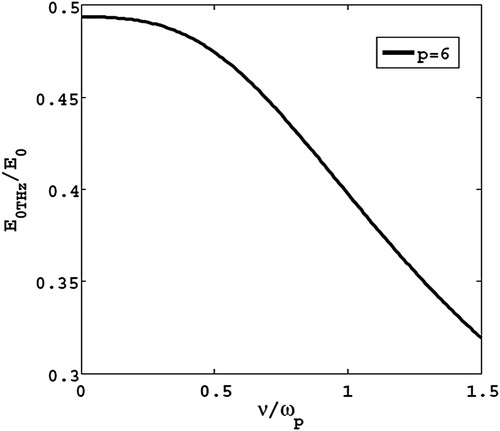
In order to clarify the role of magnetic field B and sG index p on the tuning of amplitude and focus of the emitted THz radiation, we have plotted Figure . This is clear from the comparison of Figures (a–c) that the effect of magnetic field is to enhance the amplitude of THz radiation. Also the focus of the THz radiation is moved away from the axis of laser propagation. For example, the peaks for the index of p = 6 shifts from about y/bw = 0.78 to y/bw = 0.92 when the magnetic field is increased from 1 T to 10 T. This observation is the same as realized in another scheme of laser beating [Citation34]. On the other hand, large amplitude and more focused THz radiation is obtained for the case of larger sG index for all the values of magnetic field. Since the ponderomotive force of the laser (with larger p) increases due to the sharper laser intensity gradient, large current is expected in the plasma that gives rise to stronger THz radiation via stronger transverse wake component.
Figure 5. THz field profile for different magnetic field and sG index, when E0 = 5×108 V/cm, p = 2, 4, 6, ω = 1.45 ωp, ν = 0.5ωp, bw = 0.01 cm, ωp = 2.0×1013 rad/sec, L = 0.5λp and ξ = − 0.8L. Here upper curves (peak wise) are for p = 6 and the lowest ones are for p = 2 (Gaussian beam).
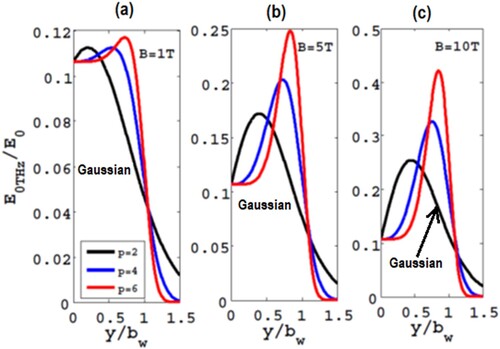
In order to prove the superiority of sG lasers over Gaussian lasers, we have plotted Figure . Here, a comparison of graphs between p = 2 and p = 4 or 6 reveals that higher field of THz radiation is realized for the use of sG lasers. Also, the effect of magnetic field is to enhance this field sharply for the case of p > 2. These results are consistent with the observation made in other schemes with sG and Gaussian lasers [Citation29,Citation34]. The effect of magnetic field suggests that the stronger THz radiation can be achieved for the case of sG lasers. It means the scheme of THz emission via wakefield could be an efficient scheme if sG lasers are used. However, this is to be mentioned that in both the cases of sG and Gaussian lasers, the maximum amplitude of THz is achieved when the lasers travel a distance of one fourth (or its odd multiples) of the laser pulse length.
Figure 6. THz field variation with applied magnetic field for various indices of lasers when E0 = 5×108 V/cm, ω = 2.4×1014 rad/sec, ωp = 2.0×1013rad/sec, ν = 0.5ωp y = 0.8bw and L = 0.5λp.
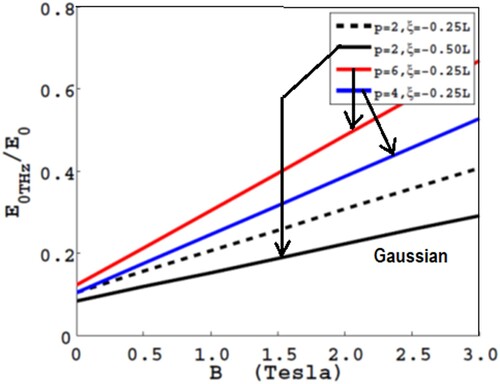
Finally, in Figure , we uncover the contribution of sG index p in enhancing both types of the fields, i.e. the wakefield and the THz radiation. For the case of sG index p > 6, the THz field amplitude gets saturated, whereas the longitudinal component keeps on enhancing under this situation also. However, the rise in THz field with p is faster than that in the wakefield. The most striking result is that the field of THz radiation saturates after p > 6 and there is no further enhancement in the amplitude. Similar observations were made in another scheme of laser beating [Citation29,Citation34].
Figure 7. THz field and longitudinal wakefield variation with sG index for bw = 0.01 cm, when E0 = 5×108 V/cm, ω = 1.15 ωp, ωp = 2.0×1013 rad/sec, B = 1 T, L = 0.5λp, ν = 0.05ωp, ξ = - 0.8L and y = 0.8bw.
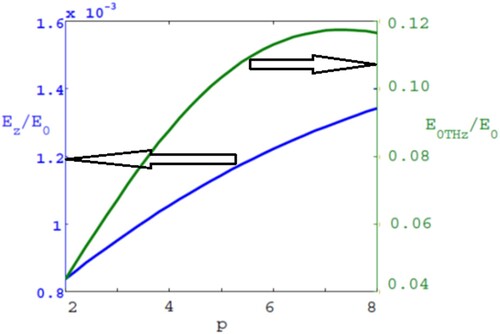
We compare our results obtained with the observations of other researchers. For examples, Hu and his coworkers [Citation35] performed 1D PIC simulations of electromagnetic radiation by wakefields in magnetized plasmas of density n0 = 1.1×1017 cm−3 corresponding to the plasma frequency fp = ωp/2π = 2.98 THz, when Gaussian lasers are used. They obtained much lower magnitudes of transverse fields than the longitudinal wakefields. However, in our scheme, Figure clearly depicts that the employment of sG laser of p = 6 enables stronger emission of electromagnetic radiation from laser wakefields. Figure also shows that the peak of the transverse field gets sharper than longitudinal field for the same set of parameters. Actually, the nonlinear effects for the case of sG lasers become stronger that make the longitudinal field steep, which produces a quick enhancement in the transverse amplitude of the wakefield. Moreover, in our scheme, magnetic field plays the same role for the enhancement of THz field amplitude as observed by Hu et al. [Citation35].
However, if we look at the technical problems for employing the present method as a convenient method to realize THz radiation source, we understand that this could be the laser pulse which may not preserve the same profile as we have introduced due to the diffraction / defocusing problem [Citation31,Citation32] and also the longitudinal component of the wakefield which is generated. Actually the application of an external magnetic field generates a transverse component of the field which acts as THz radiation source. This way one component of the wakefield is not properly used and energy is diverted. The present scheme employed super-Gaussian laser beams which are different from the usual Gaussian beams, as the highest field in sG beam stays for larger distance and there is a sharp gradient in the field which further enhances for the increasing values of p. This difference is clearly shown in Figure .
6. Conclusions
The present study in collisional magnetized plasma reveals that the transverse wakefield gives rise to the electromagnetic radiation in the THz frequency range when we use the super-Gaussian lasers. Wake component in the direction of external magnetic field stays neglected under the said situation. Collisions between the electrons and neutrals not only lead to the decay in amplitude of emitted THz radiation but also limit the focusing of radiation. However, external magnetic field applied in perpendicular direction can compensate this decay and defocusing. Employment of lower beam width sG laser over Gaussian laser further enables the tuning of the radiation field amplitude and also enhances the magnitude of emitted THz radiation.
Acknowledgement
DST and DRDO, Government of India are gratefully acknowledged for the financial support.
Disclosure statement
No potential conflict of interest was reported by the author(s).
Correction Statement
This article has been republished with minor changes. These changes do not impact the academic content of the article.
Additional information
Funding
References
- Deutsch C, Furukaw H, Mima K, et al. Focusing of Hermite-cosh-Gaussian laser beams in collisionless magnetoplasma. Phys. Rev. Lett. 1996;77:2883–2486.
- Teubner U, Gibbon P. High-order harmonics from laser-irradiated plasma surfaces. Rev Mod Phys. 2009;81(2):445.
- Sullivan A, Hamster H, Gordon SP, et al. Propagation of intense, ultrashort laser pulses in plasmas. Opt Lett. 1994;19(19):1544–1546.
- Faure J, Rechatin C, Norlin A, et al. Controlled injection and acceleration of electrons in plasma wakefields by colliding laser pulses. Nature. 2006;444(7120):737–739.
- Jung C. International seminar on advanced accelerator and radiation physics. Synchrotron Radiat News. 2016;29:11–13.
- Li XF, Yu Q, Gu YJ, et al. Calculating the radiation characteristics of accelerated electrons in laser-plasma interactions. Phys Plasmas. 2016;23(3):033113.
- Yugami N, Higashiguchi T, Gao H, et al. Experimental observation of radiation from Cherenkov wakes in a magnetized plasma. Phys Rev Lett. 2002;89(6):065003.
- Starodubtsev M, Krafft C, Lundin B, et al. Resonant Cherenkov emission of whistlers by a modulated electron beam. Phys Plasmas. 1999;6(7):2862–2869.
- Lemos N, Martins JL, Tsung FS, et al. Self-modulated laser wakefield accelerators as x-ray sources. Plasma Phys Controlled Fusion. 2016;58(3):034018.
- Umstadter DP. Proceedings of SPIE - The International society for optical engineering, 9590, art. no. 959002. doi:10.1117/12.2196369, (2015).
- Demir P, Kacar E, Akman E, et al. Proceedings of SPIE - The International Society for Optical Engineering 6703 (2007); P. Demir, E. Kacar, S. K. Bilikmen, X-Ray Lasers 2008 Volume 130 of the series Springer Proceedings in Physics pp 281-287 (2008).
- Dorranian D, Ghoranneviss M, Starodubtsev M, et al. Generation of short pulse radiation from magnetized wake in gas-jet plasma and laser interaction. Phys Lett A. 2004;331(1-2):77–83.
- Dorranian D, Ghoranneviss M, Starodubtsev M, et al. Microwave emission from TW-100 fs laser irradiation of gas jet. Laser Part Beams. 2005;23(4):583–596.
- Manouchehrizadeh M, Dorranian D. Effect of obliqueness of external magnetic field on the characteristics of magnetized plasma wakefield. Journal of Theoretical and Applied Physics. 2013;7(1):43.
- Starodubtsev M, Kamal-Al-Hassan M, Ito H, et al. Low-frequency sheath instability stimulated by an energetic ion component. Phys Plasmas. 2006;13(1):012103.
- Mun J, Park S, Yea K. Relationship between Terahertz and X-ray signals generated from laser-Induced plasma on gas targets. J Korean Phys Soc. 2010;56(11):275–278.
- Nakajima K. Proceedings of the Japan Academy Series B: Physical and Biological Sciences, 91(6); 2015. p. 223-245. doi:10.2183/pjab.91.223,.
- Carnio BN, Hopmann E, Zawilski KT, et al. Dependence on excitation polarization and crystal orientation for terahertz radiation generation in a BaGa 4 Se 7 crystal. Opt Express. 2020;28(10):15016–15022.
- Grishkov VE, Uryupin SA. Generation of terahertz radiation in dielectric–metal structure irradiated by a femtosecond laser pulse. Opt Lett. 2020;45(1):41–44.
- Sharma D, Singh D, Malik HK. Shape-dependent Terahertz radiation generation through nanoparticles. Plasmonics. 2020;15(1):177–187.
- Guo F, Wang C, Nie T, et al. Generation of highly efficient terahertz radiation in ferromagnetic heterostructures and its application in spintronic terahertz emission microscopy (STEM). OSA Continuum. 2020;3(4):893–902.
- Malik AK, Malik HK, Kawata S. Investigations on terahertz radiation generated by two superposed femtosecond laser pulses. J Appl Phys. 2010;107(11):113105.
- Jha P, Saroch A, Mishra RK. Generation of wakefields and terahertz radiation in laser-magnetized plasma interaction. EPL (Europhysics Letters). 2011;94(1):15001.
- Wang WM, Sheng ZM, Wu HC, et al. Strong terahertz pulse generation by chirped laser pulses in tenuous gases. Opt Express. 2008;16(21):16999–17006.
- Wang WM, Kawata S, Sheng ZM, et al. Towards gigawatt terahertz emission by few-cycle laser pulses. Phys Plasmas. 2011;18(7):073108.
- Chen ZY. High field terahertz pulse generation from plasma wakefield driven by tailored laser pulses. Appl Phys Lett. 2013;102(24):241104.
- Villa F, Anania MP, Bellaveglia M, et al. Laser pulse shaping for high gradient accelerators. Nucl Instrum Methods Phys Res Sect A. 2016;829:446–451.
- Ostermayr T, Petrovics S, Iqbal K, et al. Laser plasma accelerator driven by a super-Gaussian pulse. J Plasma Phys. 2012;78(4):447–453.
- Singh D, Malik HK. Enhancement of terahertz emission in magnetized collisional plasma. Plasma Sources Sci Technol. 2015;24(4):045001.
- Wu HC, Sheng ZM, Dong QL, et al. Powerful terahertz emission from laser wakefields in inhomogeneous magnetized plasmas. Physical Review E. 2007;75(1):016407.
- Devi L, Malik HK. Resonant third harmonic generation of super-Gaussian laser beam in a rippled density plasma. Journal of Theoretical and Applied Physics. 2018;12(4):265–270.
- Malik HK, Devi L. Relativistic self focusing and frequency shift of super-Gaussian laser beam in plasma. Results in Physics. 2020. doi:10.1016/j.rinp.2020.103070.
- Zhidan H, Zhengming S, Wenjun D, et al. Electromagnetic emission from laser wakefields in magnetized underdense plasmas. Plasma Sci Technol. 2012;14(10):874.
- Singh D, Malik HK. Terahertz generation by mixing of two super-Gaussian laser beams in collisional plasma. Phys Plasmas. 2014;21(8):083105.
- Hu ZD, Sheng ZM, Ding WJ, et al. Electromagnetic emission from laser wakefields in underdense magnetized plasmas. J Plasma Phys. 2012;78(4):421–427.
- Singh D, Malik HK, Nishida Y. Magnetic-field–driven Terahertz radiation through wakefield excited by skew-chG lasers in collisional plasma. EPL (Europhysics Letters). 2019;127(5):55001.
- Malik HK. Generalized treatment of skew-cosh-Gaussian lasers for bifocal terahertz radiation. Phys Lett A. 2020. doi:10.1016/j.physleta.2020.126304.
- Malik AK, Malik HK, Nishida Y. Terahertz radiation generation by beating of two spatial-Gaussian lasers. Phys Lett A. 2011;375(8):1191–1194.
- Malik HK. Analytical calculations of wake field generated by microwave pulses in a plasma filled waveguide for electron acceleration. J Appl Phys. 2008;104(5):053308.
- Aria AK, Malik HK, Singh KP. Excitation of wakefield in a rectangular waveguide: Comparative study with different microwave pulses. Laser Part Beams. 2009;27(1):41–47.
- Aria AK, Malik HK. Numerical studies on wakefield excited by Gaussian-like microwave pulse in a plasma filled waveguide. Opt Commun. 2009;282(3):423–426.
- Malik HK, Kumar S, Nishida Y. Electron acceleration by laser produced wake field: pulse shape effect. Opt Commun. 2007;280(2):417–423.
- Malik L, Escarguel A. Role of the temporal profile of femtosecond lasers of two different colours in holography. EPL (Europhysics Letters). 2019;124(6):64002.
- Malik L. Dark hollow lasers may be better candidates for holography. Opt Laser Technol. 2020;132:106485.

